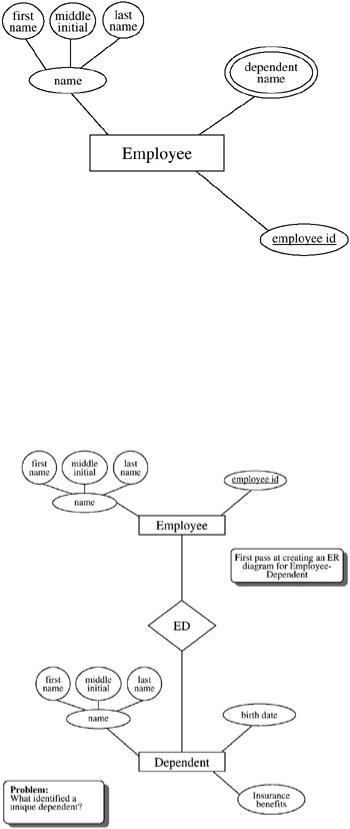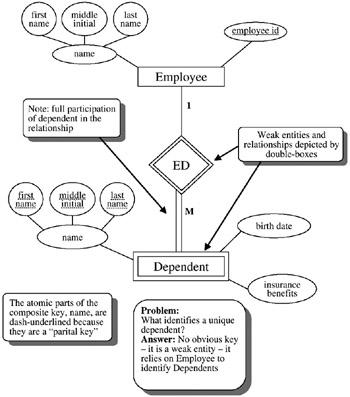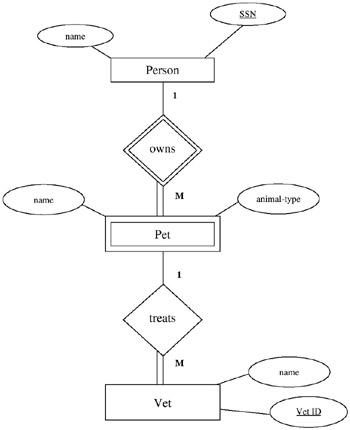
Моделирование бизнес-процессов / Моделирование бизнес-процессов / ER-диаграмы / 0849315484 Entity-Relationship Diagrams
.pdfChapter 5: The Weak Entity
Chapters 2 and 3 introduced the concepts of the entity, the attribute, and the relationship. Chapter 4 dealt with structural constraints, that is, how two entities are related to one another. This chapter discusses the concept of the "weak" entity, which is used in the Chen-like model. Weak entities may not have a key attribute of their own, as they are dependent on a strong or regular entity for their existence (that has a key attribute of its own). The weak entity has some restrictions on its use, and produces some interesting diagrams. This chapter revisits and redefines steps 3 and 4 of the ER design methodology to include the concept of the weak entity. A grammar for the weak entities and mapping rules for the weak entities are also developed.
Strong and Weak Entities
As discussed in Chapter 2, there are situations where finding a key to a relationship is difficult. So far, we have concentrated on examples with strong (regular) entities — mostly ones with easily identifiable keys. Strong entities almost always have a unique identifier that is a subset of all the attributes; a unique identifier may be an attribute or a group of attributes. For example, a student number, an automobile vehicle identification number, a driving license number, etc. may be unique identifiers of strong entities.
A weak entity is one that clearly will be an entity but will depend on another entity for its existence. As previously mentioned, a weak entity will not necessarily have a unique identifier. A classic example of this kind of entity is a DEPENDENT as related to an EMPLOYEE entity. If one were constructing a database about employees and their dependents, an instance of a dependent would depend entirely on some instance of an employee, or else the dependent would not be kept in the database. The EMPLOYEE entity is called the owner entity or identifying entity for the weak entity DEPENDENT.
How can a weak entity come about in our diagrams? In the creation of a database, we might have a dependent name shown as a multi-valued attribute, as shown in Figure 5.1. An example of data for a diagram like Figure 5.1 would be:
|
EMPLOYEE |
|
name (First, MI, Last) |
emp ID |
dependents |
|
|
|
John J. Jones |
0001 |
John, Jr; Fred; Sally |
Sam S. Smith |
0004 |
Brenda; Richard |
Adam A. Adams |
0007 |
John; Quincy; Maude |
Santosh P. Saha |
0009 |
Ranu; Pradeep; Mala |
|
|
|

Figure 5.1: The EMPLOYEE Entity Showing DEPENDENT Name as a Multi-Valued Attribute
Suppose that in our conversations with the user, we discover that more information is supposed to be gathered about the dependents themselves. Following our methodology, this acknowledgment is a recognition that the dependents should be entities; that is, they fit the criteria for "entity," which is that we would be recording information about "something" (the dependent). Hence, we would be describing an entity called DEPENDENT. If we make DEPENDENT an entity, we would embellish the diagram in Figure 5.1 to that of Figure 5.2.
Figure 5.2: The EMPLOYEE–DEPENDENT ER Diagram — First
Pass

Figure 5.2 poses a problem: the DEPENDENT entity is dependent on the EMPLOYEE for its being. Also, it has no clear unique identifier. This dependence on EMPLOYEE makes DEPENDENT a weak entity. As is often the case with weak entities, neither name, birth date, nor insurance benefits are candidate keys by themselves. None of these attributes would have unique values. There is no single attribute candidate key.
In the Chen-like model, for weak entities, we enclose the entity in a double box, and the corresponding relationship to the owner in a double diamond (see Figure 5.3). The weak entity in Figure 5.3, the DEPENDENT, is said to be identified by the entity EMPLOYEE; the EMPLOYEE is called the "identifying entity" or "owner entity" for the weak entity, DEPENDENT.
Figure 5.3: The EMPLOYEE–DEPENDENT ER
Diagram
Attributes are handled the same way for weak entities as for strong entities (except that there may be no primary keys for weak entities). We have included some attributes in Figure 5.3 so that the figures depict the following (in loose grammar):
A dependent must be related to one employee and an employee may have many dependents.
The DEPENDENT entity has the following attributes: name (a composite attribute), birth date, and insurance benefits.
In dealing with weak entities, it is appropriate to consider how each instance of the entity would be identified. Because the owner of the weak entity, DEPENDENT, is the strong entity EMPLOYEE, the identification process would involve the EMPLOYEE key plus some information from the weak entity, DEPENDENT. Name is a likely candidate as an identifier for
DEPENDENT, and will be called a partial key.
In Figure 5.3, we have dash-underlined the atomic parts of the composite attribute, name. Name is a partial key as it identifies dependents, but not uniquely. Because name is composite, the atomic parts of it are distinguished as the partial key. This assumes that all dependents have unique names.
In Figure 5.3, we did not "name" the relationship, and left it as ED for EMPLOYEE-DEPENDENT. Suitable names for the dependent might be "have," as in:
Employees may have many dependents.
or "dependent upon" as in
Employees may have many dependents dependent upon them.
We could also have used "related to," as in:
Employees are related to many dependents.
Each of these verb phrases seems to have a redundancy (dependent upon) or perhaps misleading (related to) air about them. Probably the best thing to do there is to leave the relationship unnamed (ED).
Weak Entities and Structural Constraints
Weak entities always have full or mandatory participation from the weak side toward the owner. If the weak entity does not have total participation, then we would have a data item in the database that is not uniquely identified, and which is not tied to a strong entity. In our EMPLOYEE–DEPENDENT example, this would be like keeping track of a dependent that is not related in any way to an employee. The cardinality of the relationship between the weak and strong entity will usually be 1:M, but not necessarily so.

Weak Entities and the Identifying Owner
There are situations in which a weak entity can be connected to an owner entity while other relationships exist apart from the "owner" relationship. For example, consider Figure 5.4. In this figure, we have shown two relationships — owns and drives — connecting the two entities, EMPLOYEE and AUTOMOBILE. Here, the AUTOMOBILE entity is considered a weak entity; that is, if there is no employee, then there will be no automobile (the automobile has to have an employee to exist in the database). Further, the automobile is identified by the owner; note the double diamond on the owns relationship, and the full participation of the AUTOMOBILE entity in the owns relationship.
Figure 5.4: A Weak Entity with Two Relationships
In Figure 5.4, we also have a drives relationship. The automobile is driven by employees other than the owner. All automobiles are driven by some employee and, hence, the participation is full. However, the driveremployee may not necessarily be the actual owner. To identify AUTOMOBILE we are saying that we need the owns relationship, but other nonowner drivers may exist.
According to Figure 5.4, one employee may own many automobiles. To answer the question — which automobiles does an employee own, in addition to the employee's_id, we will need to know the make, model, and color of the automobiles. The make, model, and color of the AUTOMOBILE entity are partial keys (dotted underline in Figure 5.4).
Checkpoint 5.1
1.How would you identify a strong entity?
2.How would you identify a weak entity?
3.What kind of a relationship line (single or double) would be leading up to the weak entity in a Chen-like diagram?
4.What kind of relationship does a weak entity have in a Chen-like model?
5.What is a partial key?

Another Example of a Weak Entity and the
Identifying Owner
As another example of a weak entity and the identifying owner in an ER diagram, consider Figure 5.5. In this figure we have two strong entities: PERSON and VET. There is one weak entity, PET. Figure 5.5 illustrates that PERSON owns PET, but the VET treats the PET. In this diagram, PERSON is the identifying or controlling entity for PET and, hence, the relationship owns has a double diamond. The relationship owns is a weak relationship. PET is a weak entity with respect to PERSON.
Figure 5.5: The PERSON–PET–VET ER Diagram
Conversely, the relationship treats does not have a double diamond because VET is not the owner of PET. Here, treats is not a weak relationship, and PET is not a weak entity with respect to VET.

Weak Entities Connected to Other Weak Entities
A final point regarding weak entities. Just because an entity is weak does not preclude it from being an owner of another weak entity. For example, consider Figure 5.6. In this figure, the EMPLOYEE–DEPENDENT relationship has been enhanced to include hobbies of the dependents. (Never mind why one would want to keep this information, but let us suppose that they do anyway).
Figure 5.6: The EMPLOYEE–DEPENDENT–HOBBY ER
Diagram
DEPENDENT is a weak entity. The entity HOBBY is also weak. Hobbies might be identified by their type (e.g., stamp collecting, baseball, tying knots, observing trains, etc.). The type attribute of HOBBY is a partial key for HOBBY.
The entity DEPENDENT is the owner of the entity HOBBY, and the entity EMPLOYEE is the owner of the weak entity DEPENDENT.
The reason that this situation is brought up here is to show that it can exist. Later, when we map this situation, we will treat this special situation carefully.
Checkpoint 5.2
1.Can a weak entity be dependent on another weak entity?
2.Can a weak entity have a relationship that is not "weak" with the identifying entity?
3.Can a weak entity be related to more than one entity (strong or weak)?
